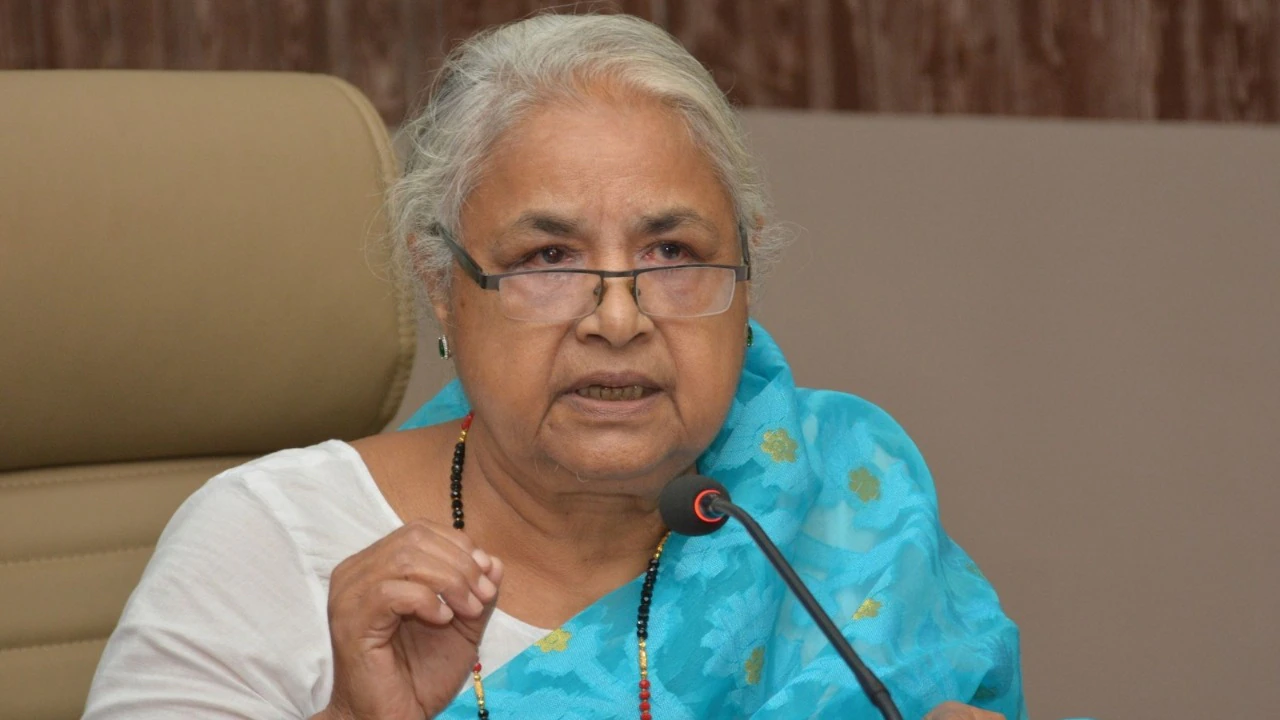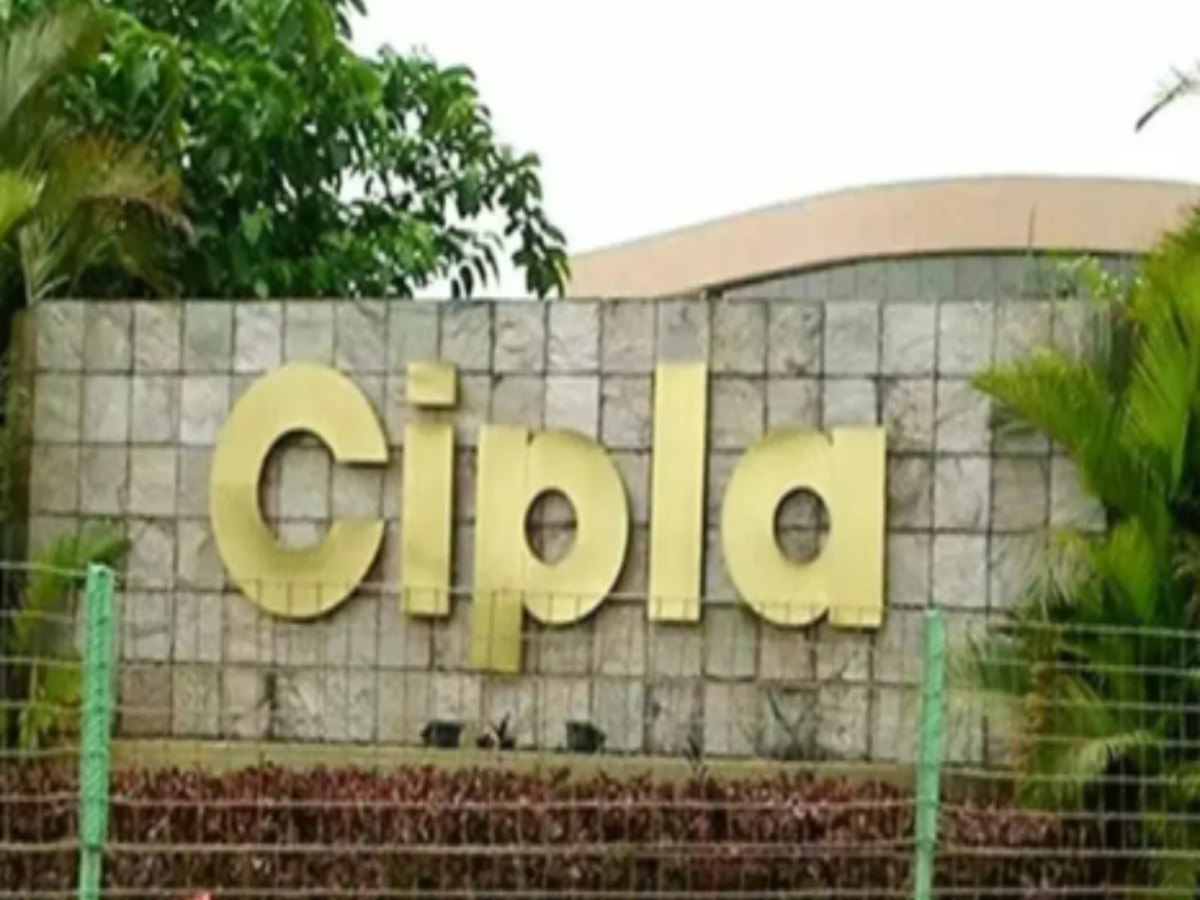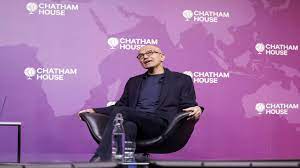Top Trending World News & Highlights


Trump's H-1B Fee Order Leads to Emirates Flight Delay as Indian Passengers Deboard
A recent policy decision from former U.S. President Donald Trump regarding increased H-1B visa fees has sparked unexpected travel disruptions. On Sunday, several Indian passengers on an Emirates flight bound for the United States chose to deboard the plane after learning mid-journey about the implications of the updated visa rule. The incident, which occurred during a scheduled stopover in Dubai, caused a delay of over three hours. The passengers, believed to be traveling on or applying for H-1B visas, reportedly became concerned about their legal or financial status upon arrival in the U.S. The fee hike — part of a broader effort to reduce visa program dependency on foreign labor — appears to have caused confusion and fear among travelers already navigating the uncertainties of immigration. Airport authorities in Dubai confirmed that the passengers voluntarily exited the aircraft before its onward journey. Emirates staff worked to reprocess baggage and seating, further prolonging the delay. No security threat was involved, and the flight eventually resumed with the remaining passengers. While U.S. immigration policy continues to shift, incidents like this highlight the real-world impact of political decisions on individuals and families. Many travelers affected by the policy are professionals who had made long-term plans based on the previous rules. Their decision to turn back speaks to the anxiety and unpredictability they face amid changing immigration landscapes.
Published 22 Sep 2025 05:43 PM


As Block Everything protests intensify, France is in chaos; will Macron step down?
France Protests: Under the banner of the "Block Everything" campaign, demonstrators staged large-scale protests around France on Wednesday, blocking highways, starting fires, and engaging in combat with law enforcement. In images reminiscent of the chaos of the 2018 "Yellow Vest" rallies, protesters set garbage cans on fire, obstructed train movement, and took over roundabouts.With no centralized leadership and ad hoc organization through social media, the demonstration is a wide-ranging manifestation of dissatisfaction. Only two days after the fall of Prime Minister Francois Bayrou's administration, it erupted in the European nation. Following the overthrow of the government on Monday and the prompt appointment of his longtime supporter, Sebastien Lecornu, as the new prime minister, French President Emmanuel Macron reportedly orchestrated the protests through Telegram channels.As thousands of people flooded onto the streets during the initial hours of unrest, the Associated Press reported that almost 300 individuals were arrested. Police used tear gas to disperse demonstrators who set barricades on fire in Paris. A bus was set on fire in Rennes, according to Interior Minister Bruno Retailleau, while train service in the southwest was suspended due to damage to a power line. Protesters, he said, were attempting to foster "a climate of insurrection."In an effort to stop the disturbance, the government of President Emmanuel Macron had sent out 80,000 police personnel nationwide. In spite of this, demonstrators set up barriers, started fires, and held protests in several locations. In Paris, trash cans were set on fire, and commuters reported traffic jams on major roads.The demonstrations expanded to many cities throughout France. In Nantes, police used tear gas on groups attempting to take over traffic circles, and protesters stopped a highway with burning tires. In Montpellier, barricades were erected at roundabouts and then taken down during altercations with police. Train services were briefly interrupted by fires in Toulouse, and attempts were made to establish additional blockades in Bordeaux. Even while the "Block Everything" movement failed to completely paralyze the nation, it did create significant flashpoints that interfered with daily life, transportation, and commutes to and from work.Meanwhile, the newly appointed Prime Minister, Sebastien Lecornu promised a “profound break" with the past on Wednesday as he faced the thorny task of trying to build a government with enough parliamentary support to pull the country out of a political crisis. Lecornu, 39, promised to find “more creative" ways than before to work with opposition parties to try to build a stable government, news agency AFP reported. “We will get there," he said during a handover ceremony. Lecornu is the seventh prime minister since Macron took office in 2017 — and the third within the space of a year.
Published 11 Sep 2025 04:24 PM


Gen-Z Favors Sushila Karki as Nepal’s Future Leader; PM Modi Recalls Ties: ‘I Remember the Ganga’
Former Chief Justice Sushila Karki has unexpectedly emerged as a favored figure among Nepal’s Gen-Z, who see her as a symbol of integrity and bold leadership in a time of political uncertainty. Despite not being affiliated with any political party, Karki’s clean track record and fearless judicial legacy have struck a chord with the younger generation, increasingly disillusioned with traditional political figures. The rising support for Karki underscores a generational desire for transparent and accountable governance. Young Nepalis, many first-time voters, are turning to leaders with proven credibility rather than political clout. Though Karki has not publicly expressed interest in entering politics, her name trending in youth forums and online polls points to a shifting political mood—one rooted in principle over populism. In a separate but timely moment, Indian Prime Minister Narendra Modi, during a recent address on India-Nepal relations, reflected on the shared cultural and spiritual history between the two nations. “I remember the Ganga,” he remarked, evoking a sense of nostalgia and emphasizing the centuries-old ties that bind the neighboring countries. His comments come amid growing calls for deeper regional collaboration and youth-led diplomacy. As Nepal’s political landscape evolves, the spotlight on Sushila Karki reflects a broader yearning for ethical leadership. With Gen-Z demanding change, the future of Nepalese politics may well be shaped by values that transcend party lines—and led by individuals once considered outside the political sphere.
Published 11 Sep 2025 03:53 PM


Le Premier ministre japonais Shigeru Ishiba se retire de ses fonctions principales et démissionne en tant que président du PLD.
According to a Reuters report, Japanese Premier Shigeru Ishiba told reporters at a media appearance that he had "taken the decision to resign as president of the PLD." A source close to the prime minister told Reuters on Sunday that he had previously told the media that he intended to step down as prime minister in order to prevent divisions within his liberal-democratic party (PLD). This decision ushers in a new era of political uncertainty for the fourth-largest economy in the world.Ishiba, who took office in September of the previous year, has seen a number of electoral setbacks, including the LDP's defeat in the July chamber of high elections. Analysts claim that one of the main causes of the reversals has been the voters' dissatisfaction with the rising cost of living.The focus now is on Ishiba's potential successor in the event that he too steps down as prime minister. Sanae Takaichi, a fiscal conservative who lost to Ishiba in the party leadership race last year, is regarded as a serious candidate. She has advocated for more expansionary fiscal policies and criticized the Bank of Japan's rate increases.
Published 08 Sep 2025 10:41 PM


World
We will here show case the latest trends in the Globe from different industries and different verticals.


Cipla shares rally 7% to hit 52-week high on strong Q3 earnings
Shares of Cipla rallied 7 percent to hit a 52-week high of Rs 1,409 in the opening trade on January 23, a day after the company reported a strong performance in Q3 on all key parameters of profit, revenue and profitability. The company's net profit for the quarter grew 32.7 percent on-year to Rs 1,049 crore despite an exceptional loss of Rs 194.8 crore. The bottomline growth was also aided by a 14.2 percent on-year increase in revenue to Rs 6,544 crore in the October-December period. Growth was largely broad-based across markets as the company clocked in its highest ever North American sales at $230 million, up 18 percent on year. The India business grew nearly 12 percent to Rs 2,859 crore, whereas sales from the South Africa recorded a near 10 percent rise to Rs 603 crore. Growth in the India business was driven by a strong performance across branded prescription, trade generics and consumer health, while that in North America was supported by continuing momentum in key assets and robust demand in base business along with some year-end buying.The South Africa business also benefitted from the increase in revenue in local currency terms. This performance was supported by positive traction in prescription, OTC (over-the-counter) and tender.


Amazon Great Republic Day Sale 2024: Best Deals on Power Banks and Wireless Chargers
Amazon Great Republic Day Sale 2024 is live for a few more hours with price cuts on different electronic items. The week-long sale started on January 13 for all Amazon India users. Besides discounts on mobile phones, tablets and laptops, the Great Republic Day Sale brings deals and offers on mobile accessories like power banks and chargers from popular brands. Bank offers are also available that provide additional discounts on a list of devices available through the online marketplace. Further, customers can avail of discounts through coupons.State Bank of India (SBI) customers are eligible to get additional instant discounts of up to 10 percent on purchases made using their cards and EMI options. Amazon is offering bundled offers in the form of exchange and no-cost EMI payment options. Meanwhile, Flipkart is also running a discount sale, which means you should compare prices across both platforms to ensure the best deal.Power banks and wireless chargers from brands like Mi and Ambrane, that will make your travel more convenient and hassle-free, are listed at affordable price tags on Amazon in the Great Republic Day Sale. Xiaomi's Power Bank 3i is currently listed with a price tag of Rs. 1,899, down from Rs. 2,199. Additionally, interested buyers can avail of up to Rs. 300 discount on purchases made via SBI cards and EMI transactions. Amazon Pay ICICI credit card users can avail of Rs. 300 cashback as well. The Xiaomi Power Bank 3i packs a large 20,000mAh lithium polymer battery and supports Quick Charge 3.0. Similarly, Portronics's Freedom Fold 15W wireless charger is available for Rs. 799, down from Rs. 1,999. Below is a list of the best deals and offers on power banks and wireless chargers that you can get during the Amazon Great Republic Day Sale 2024 today. Is the Samsung Galaxy Z Flip 5 the best foldable phone you can buy in India right now? We discuss the company's new clamshell-style foldable handset on the latest episode of Orbital, the Gadgets 360 podcast. Orbital is available on Spotify, Gaana, JioSaavn, Google Podcasts, Apple Podcasts, Amazon Music and wherever you get your podcasts.For the latest tech news and reviews, follow Gadgets 360 on X, Facebook, WhatsApp, Threads and Google News. For the latest videos on gadgets and tech, subscribe to our YouTube channel.


Realme 12 Pro+ Camera Details Revealed Ahead Of Launch
Realme has already confirmed that it will launch its Relame 12 series of smartphones later this month. The Chinese smartphone maker has revealed that it will launch the Realme 12 Pro and Realme 12 Pro+ smartphones on January 29 in India. Relame has revealed that the Realme 12 Pro+ will come in two colour options — blue and cream. The smartphone will sport a circular camera module with triple rear camera setup. The company has revealed that the upcoming Relame 12 series smartphone will sport a 64MP main camera with 120X zoom functionality. The smartphone comes equipped with a Sony IMX890+ sensor with optical image stabilisation. The smartphone also house a Periscope Portrait camera. The periscope zoom camera in question utilizes a 64MP OmniVision OV64B sensor with a substantial 1/2-inch dimension. Realme emphasizes that, when compared to the 3x zoom camera in the iPhone 15 Pro (12MP) and the Samsung Galaxy S23 Ultra (10MP), the Realme 12 Pro+'s sensor is significantly larger, exceeding 2.6 times in size. Consequently, this results in over 1.8 times the light intake.In simpler terms, mainstream flagship phones often do not prioritize telephoto cameras. The comparison images presented during the launch event were compelling, demonstrating Realme's ability to maintain an impressive level of detail even with significant cropping. However, a conclusive assessment will be provided based on our hands-on experience in the future.


Go Nisha Go game empowers 2,000 girls in Patna, Jaipur, and Delhi about menstrual health and more
This mobile game is empowering girls in India with knowledge that changes lives. Howard Delafield International (HDI), a woman-owned social impact firm, hosted an event in New Delhi on January 18 highlighting the impact of the award-winning mobile game Go Nisha Go. Developed with support from USAID, this innovative role-playing game aims to shape knowledge and behaviours among adolescent girls aged 15-19, empowering them to reach their full potential.Since its launch, Go Nisha Go has been downloaded over 300,000 times. Players take on the role of Nisha, the protagonist, and make important choices that significantly influence her life journey. Through Nisha, girls can explore critical topics like menstrual health, consent, contraception, pursuing an education, delaying early marriage, and gaining financial independence. The game provides credible information and advice from mentor figures to help guide the choices. Access to in-game resources combined with the ability to make decisions and see the outcomes has led to measurable impact, as shown by a randomised control trial conducted by Population Council Consulting. The study enlisted approximately 2000 girls in Patna, Jaipur, and Delhi – regions with high rates of early marriage and adolescent pregnancy which can disrupt a girl’s education and life prospects.The research revealed that girls who played Go Nisha Go demonstrated substantially improved knowledge compared to those who did not play the game. Players were at least twice as likely to have comprehensive awareness of modern contraceptives like condoms, birth control pills, and emergency contraception. Understanding of fertility and the menstrual cycle increased by 119%. Significant gains were also seen in knowledge of menstrual issues, timing of marriage, and contraception.Beyond expanding knowledge, the game also boosted self-efficacy and intent among players. Girls felt more confident in accessing health services and speaking to providers about their needs. They were more determined to pursue their education, delay marriage, and gain financial independence.


Google Pay, NPCI Sign MoU to Expand UPI Globally, Aim to Ease Digital Payments Abroad
Google Pay and National Payments Corporation of India (NPCI) will work together to expand Unified Payments Interface (UPI), the instant payments system widely used in the country, to international markets, Google and NPCI confirmed Wednesday. A Memorandum of Understanding (MoU) has been signed between Google Pay India and NPCI subsidiary, NPCI International Payments Ltd (NIPL), to bring the instant payment functionality to other countries. UPI has become a widespread mode of digital payment throughout India in recent years, with interoperability between payments apps like Google Pay, PhonePe, and Paytm. The value processed via UPI payments in 2023 stood at Rs. 167 lakh crores, according to Google.The MoU signed between Google Pay India and NIPL primarily seeks to ease digital payments abroad for travellers outside of India. The collaboration will also aid in establishing a UPI-style digital payments infrastructure in other countries, a press release for the announcement said. Additionally, Google and NPCI also aim to leverage the UPI infrastructure to ease the process of remittances between countries, thus simplifying cross-border financial exchanges. “UPI has demonstrated to the world the step change that happens in economies with the introduction of interoperable, population scale digital infrastructure and each economy that joins such networks will create impact beyond the sum of parts,” Deeksha Kaushal, director of partnerships at Google Pay India said.According to the press release, the initiative will also help bring Indian customers to foreign merchants, reducing the need for credit or forex cards and instead allow UPI apps like Google Pay for international digital payments. “This strategic partnership will not only simplify foreign transactions for Indian travellers but will also allow us to extend our knowledge and expertise of operating a successful digital payments ecosystem to other countries,” Ritesh Shukla, CEO of NPCI International Payments Limited, said. Last year, Google Pay introduced a UPI Lite feature on its platform that enables small-value digital payments with just one tap, without the need to enter the UPI PIN, as required in regular transactions. UPI Lite supports a maximum instant transaction of up to Rs. 200 at a time. Users can load their UPI Lite account with up to Rs. 2,000, twice a day.In August, the Reserve Bank of India (RBI) increased the UPI Lite transaction limit from Rs. 200 to Rs. 500. The overall wallet limit, however, was retained at Rs. 2,000 only. A month later, NPCI said that UPI transactions had crossed the 10-billion mark in August. According to the NPCI data, number of UPI transactions stood at 10.24 billion on August 30. In value terms, the transactions amounted to Rs. 15,18,456.4 crore exchanging hands.


Apple Vision Pro to Support Several Streaming Services in the US; to Feature 3D Versions of Over 150 Movies
Apple Vision Pro is set to arrive next month and the Cupertino company has now revealed a list of streaming services that will be supported when its first mixed reality headset makes its debut in the US. Meanwhile, customers who want to watch content from other services can do so via Safari, according to Apple. The Vision Pro headset will allow wearers to watch both 2D and 3D movies and over 150 movies will be available on the headset when it is launched. The company has announced that the Apple Vision Pro will support several streaming services such as Amazon Prime Video, Crunchyroll, Discovery+, Disney+, ESPN, Fubo, IMAX, MLB, MUBI, Max, NBA, PGA Tour, Paramount+, Peacock, Pluto TV, Red Bull TV, TikTok, and Tubi. These platforms will allow users to download and stream TV shows and movies or watch sports content with their subscription. Streaming applications will also be able to take advantage of the immersive features offered by the Apple Vision Pro. Four 'environments' will be available on the headset — the El Capitan Theatre-inspired by Disney+ Theater, the Scare Floor from Monster's Inc, the cockpit of Luke Skywalker's landspeeder, and the view of downtown Manhattan from Marvel's Avengers Tower, according to the company.Meanwhile, the Apple Vision Pro will allow you to view movies in 2D and 3D with Spatial Audio — customers will have access to 150 3D movies including Avatar: The Way of Water, Dune, Spider-Man: Into the Spider-Verse, and The Super Mario Bros. Movie. Other 3D movies will also be available to rent or buy via the Apple TV app, according to the company.Scheduled to arrive in the US on February 2, the Apple Vision Pro is equipped with dual micro-OLED displays with a combined 23 million pixels. The headset is powered by the company's M2 chip for CPU, GPU, and NPU tasks, while another, new M2 based chip called R1 handles streaming to the display. Apple's headset is powered by an external battery pack that offers up to 2.5 hours of battery life.The device has an eye-watering $3,499 (roughly Rs. 2.9 lakh) price tag, while customers who wear spectacles will have to shell out more for Zeiss optical inserts. The company is yet to provide a timeline for the launch of the Apple Vision Pro in other markets — including India, but more information could be made available in the coming months.


“There Will Be Jobs”: Microsoft CEO Satya Nadella On How AI Will Change Workplace
Artificial Intelligence (AI) is considered to be one of the key developments of 2023 as tech honchos highlighted the positive impact of the technology across society. However, several C-suite executives, including OpenAI’s Sam Altman and Google CEO Sundar Pichai have hinted at job cuts, sugarcoating what’s to come.Microsoft CEO Satya Nadella has shared his take and just like his industry peers, he has also painted an optimistic picture, saying that there will be a reduction in jobs as we know but different types of jobs will be created that will require new sets of skills. “There will be jobs, the question is the shape of these jobs. If anything, these tools can be very helpful with getting us the skills for what is the new set of tasks,”Artificial Intelligence (AI) is considered to be one of the key developments of 2023 as tech honchos highlighted the positive impact of the technology across society. However, several C-suite executives, including OpenAI’s Sam Altman and Google CEO Sundar Pichai have hinted at job cuts, sugarcoating what’s to come. Microsoft CEO Satya Nadella has shared his take and just like his industry peers, he has also painted an optimistic picture, saying that there will be a reduction in jobs as we know but different types of jobs will be created that will require new sets of skills.“There will be jobs, the question is the shape of these jobs. If anything, these tools can be very helpful with getting us the skills for what is the new set of tasks,” he said at London’s Chatham House, a day before heading to Davos for the World Economic Forum.“Everyone can become an expert in anything because they have an AI assistant,” he added.His comments came soon after the International Monetary Fund (IMF) said that AI is set to affect nearly 40% of all jobs, with IMF’s managing director Kristalina Georgieva adding that “in most scenarios, AI will likely worsen overall inequality”. Nadella on use cases of AINadella also said that generative AI products like ChatGPT should be welcomed as they disrupt how people get access to information.“Let’s face it, there’s a real aggregation power in a few places, right? Search is one. News feeds is another. Both of these things could be up for disruption,” Nadella said, adding that as a result, journalists and publishers “should welcome” generative AI, as per a report by Politico.Recently, The New York Times filed a lawsuit against both OpenAI and Microsoft accusing the companies of copyright infringement. It said that the outlet’s journalistic content was used to train models underlying the ChatGPT AI chatbot.


Dakar 2024 Result: Harith Noah Wins in Rally 2 Class, Hero MotoSports Makes History
The 2024 Dakar Rally was a great event that came to a close. After years of KTM domination, Honda finally won the Dakar Rally, with Hero MotorSports finishing in second place, just behind the KTMs. It is worth mentioning that Harith Noah won the Rally 2 class, which was a significant milestone for India in the Dakar Rally.The short 175km special stage of the day was all KTM, as the brand was on full display with a 1-2 podium finish. Toby Price won the stage, with defending champion Kevin Benavides in hot pursuit. But the overall winners were decided over the previous days, and Honda's Ricky Brabec was in the lead from the start. For a short time, Hero's Ross Branch was the race leader. After Benevides and Price of KTM crossed the finish line first and second, Adrien Van Beveren of KTM took third.As the only manufacturer entered in the Rally 2 class of this year's Dakar Rally, Harith Noah—supported by TVS—and Sherco were the only competitors to stand out. After finishing the most recent stage in eleventh place, the Indian rider won the Rally 2 class overall. Even in the overall standings, Noah's performance was remarkable. He finished the 2024 Dakar Rally in eleventh place, making history as the first Indian to ever win a stage, finish on the podium, and finish in the top fifteen.Noah showed resiliency by overcoming health issues in the first week and then picked up steam in the second week of the competition. His incredible jump from 18th to 13th place overall over the 48H Chrono Stage 6 is worth noting. Stage 8 and Stage 10, in which he twice set the fastest rally, were particularly impressive for his sustained growth.It's important to remember that RallyGP and Rally 2 are two separate classes. Only highly experienced racers who have been accepted by the FIM Championship Committee based on their sports credentials are allowed to compete in the RallyGP class. Rally 2 offers a more welcoming environment for riders from various backgrounds since it is available to anyone who isn't already in the RallyGP riders' registration.Despite finishing ten minutes and fifty-three seconds behind winner Ricky Brabec, Hero MotoSports' Ross Branch managed an outstanding second-place finish in the 2024 Dakar Rally. Hero MotoSports has achieved a remarkable feat, becoming the first Indian team to secure a podium place in the esteemed race.By the end of the sixth stage of the 2024 Dakar Rally, three of Hero's four riders had pulled out due to the extreme difficulties they had encountered. Ross Branch was the sole Hero MotoSports competitor in Dakar 2024, despite the team's other three riders withdrawing: Joaquim Rodrigues, Sebastian Buhler, and Joan Barreda Bort. Nevertheless, he quickly established himself as a strong candidate for the ultimate win.Branch won the first stage of the rally and remained in first place until the fifth stage. He showed his skill by finishing second in Stage 11 with the fastest time and then followed Honda's Ricky Brabec closely in the following stages.Ross Branch said: “Finally finished the Dakar!! It was a really tough Dakar 2024, and I'm so thrilled to be here! Finishing on the podium was always the goal, and today it's a dream come true. I'm really over the moon to achieve this goal for Hero. And a big thank you to the team for developing a highly competitive machine, for the sleepless 3 weeks here, and for everything they've sacrificed to reach to this point. I'm really proud of my team. We've got some more work to do to be on the next step, so we'll look forward to that in the next year. A big thank you to everyone for your continued support from all around the world!”With a ninth-place finish in the last 174-kilometre stage near Yanbu, the South African rider solidified his position as second overall. This incredible feat not only marks Branch's first podium finish at the Dakar, but it also marks the first podium for an Indian team in the history of the race.


Hyundai Motor India Acquires GMs Talegaon Plant; to Invest Rs 6,000 Crore in Maharashtra
Hyundai Motor India Ltd. (HMIL), has acquired the Talegaon factory of General Motors India, located in Pune, Maharashtra. Following the fulfillment of specific requirements and obtainment regulatory clearance from the relevant government departments and stakeholders, the acquisition has been completed. Hyundai Motor India has also inked a formal Memorandum of Understanding (MoU) with the Maharashtra government. With this, it has pledged to spend Rs 6,000 crore in the state. At the moment, the Talegaon factory produces 1,30,000 units per year. To reach its targets, the automaker plans to increase production capacity even further. HMIL states that the facility will be updated to meet the company's global manufacturing and operational needs. To achieve production excellence, investments will be undertaken in stages to gradually update the plant's existing infrastructure and equipment.Mr. Un Soo Kim, MD & CEO, of Hyundai Motor India Ltd., shared his thoughts on the acquisition and commented ''India is a very important market for Hyundai Motor Company, and we are committed to providing benchmark creating products & technologies to Indian customers. As we look forward to the next decade of progress for Hyundai Motor India, it is critical for us to augment our manufacturing capacity in India.''He further added ''The Talegaon manufacturing plant will play the role of a catalyst in achieving HMIL’s 1 million annual production capacity milestone. The acquisition of the Talegaon plant reinforces our commitment to ‘Atmanirbhar Bharat’ (Self-Reliant India), by making India a hub for advanced smart mobility solutions, Make-In-India for the world. Our manufacturing operations are scheduled to begin in Talegaon, Maharashtra in the year 2025.”With a starting price of Rs 10.99 lakh (ex-showroom), Hyundai launched the eagerly awaited Creta Facelift in India on January 16. Along with many interior upgrades and a new engine option, the facelift gives the car a more robust exterior look. Over 70 safety features—36 of which are standard—are included in the recently redesigned Creta. TPMS, electronic stability control, an all-wheel disc brake system, and six airbags are a few of them. The highest-spec versions come with 19 Level 2 ADAS features (Hyundai SmartSense).The 1.5-litre naturally aspirated (NA) and 1.5-litre CRDi diesel engine options for the SUV remain the same. However, a new 1.5-litre turbocharged GDi petrol engine is now offered as an option in this lineup. The new 1.5-litre turbocharged GDi petrol unit delivers 158bhp and 253Nm of performance numbers.


Volvo’s 10,000th car in India is its first pure electric offering
Volvo Car India has achieved a significant milestone by producing its ten thousandth car at its Bangalore facility. The company, which began assembly operations in 2017, has seen the highest production of the XC60 model, with over 4000 units produced to date.Jyoti Malhotra, Managing Director of Volvo Car India, in a company statement, revealed that the honour of being the ten thousandth car produced goes to the XC40 Recharge, the company's first pure electric offering.Malhotra said, "It is indeed a matter of pride for the company to have reached this milestone in a short span of time in spite of nearly three years of pandemic disruptions."Gao Feng, Production Head of Volvo Car India, highlighted the plant's achievement of rolling out India's first domestically assembled electric vehicle (EV), the XC40 Recharge. Today, the company assembles all its models in India, including the XC90, XC60, S90, XC40 Recharge, and the recently launched C40 Recharge.Meanwhile, Volvo Car India announced a 2% price increase for its conventional engine vehicles on Monday, while the prices of its EV offerings remain unchanged.Following the price hike, the XC60 is priced at ₹68.9 lakh, the S90 at ₹68.25 lakh, and the XC90 at ₹1,00,89,000.However, the prices of the XC40 Recharge and C40 Recharge remain unchanged at ₹57.9 lakh and ₹62.95 lakh, respectively.


Hyundai introduces ‘IONIQ 5 N NPX1’ concept with N Performance Parts
Hyundai Motor Company has unveiled the ‘IONIQ 5 N NPX1’, a concept model equipped with prototype N Performance Parts, at the Tokyo Auto Salon 2024. The ‘NPX1’ is the first N Performance Parts concept model based on the company’s high-performance electric vehicle (EV) IONIQ 5 N. The company plans to enhance the EV ownership experience with N Performance Parts, a project that began in 2019 and continues to develop high-quality tuning parts for customers. Following the success of internal combustion engine vehicles such as the Elantra N, i30 N, and i20 N, Hyundai N plans to offer specialised tuning components for all-electric N models, including the IONIQ 5 N.The ‘NPX1’ concept model previews a range of N-specific enhancements that will soon be available for purchase from a catalogue of N Performance Parts.These enhancements include a carbon front splitter, side skirts, rear diffuser, rear wing spoiler, lightweight hybrid carbon wheels, high-performance brake pads, and lowering springs. The concept model’s interior is further enhanced with Alcantara material and racing bucket seats.The prototype N Performance Parts applied to the NPX1 concept will be further developed for production in preparation for sales in 2024. Starting with the IONIQ 5 N, Hyundai N will expand the availability of N Performance Parts products for all N models.Joon Park, Vice President of N Brand Management Group at Hyundai, said, “In 2024, Hyundai Motor Company will take a step forward as a leader in new tuning parts suitable for the high-performance EV era as demonstrated with the ‘NPX1’ concept model.”He added that the company is also developing software customisation such as sound and vehicle calibration by over-the-air (OTA) updates, opening a completely new category of EV customisation for an exciting future for the tuning community.


Tata Punch facelift launch confirmed for 2025
The Tata Punch petrol will see a mid-life facelift sometime next year. Confirming this development on the sidelines of the Punch EV launch, Tata Motors’ Passenger Vehicles Unit MD, Shailesh Chandra, said, “As far as the upgrade of the Punch is concerned, you know that it was launched in October 2021. Typical facelift period is three years. So, we should be expecting a facelift for the ICE version only in mid-2025, or slightly later.” Just like what we’ve seen on the Nexon and Harrier facelifts recently, expect Tata Motors to update the Punch SUV’s styling with fresh design cues to bring it in line with the newer Tata models. Changes to the front bumper and grille, along with minor tweaks to the headlamps and the bonnet can be expected to make the small SUV look new.Like the Nexon and the Nexon EV facelift, there will be styling bits that will help differentiate the petrol-powered Punch from the recently launched Punch EV. What’s more, Chandra also said that the Punch will have feature differences between the petrol and EV versions.


Renault Bigster global debut later this year
The new Renault Bigster SUV will see a global debut later this year and is expected to go on sale internationally by early 2025. Revealed as a concept in 2021, it is essentially a three-row iteration of the all-new Duster, which made its global debut a few months ago. Sources have conveyed to our friends at Motor1 Brazil that the Bigster SUV will share its design cues largely with the new Duster and the Bigster concept. Essentially, it will be most likely an elongated version of the Duster, similar to what we see with the Creta and Alcazar in India. There will, however, be styling, tech and equipment differences on the inside and out. This new SUV from Renault will be around 4.6 metres long – nearly 0.3 metres longer than the new Duster, which measures 4.34 metres. It will get rugged looks and interior bits from the Duster, but there will be more upmarket materials and additional creature comforts to justify the SUV's higher price tag. The Duster currently has a 2,657mm wheelbase, which also could see an increment for the Bigster in order to facilitate easy ingress-egress and more cabin room. As far as the platform goes, the Bigster will share the same CMF-B modular architecture. There isn’t much known about its powertrain options, however, it will be safe to expect that the SUV will share its powertrain line-up with the latest-gen Duster, which comes with three engine options – two of which are electrified. Starting the proceedings is the 1.6-litre four-cylinder petrol hybrid that gets two electric motors; this engine comes with an automatic gearbox. It also comes with regenerative braking and a 1.2kWh battery, enabling purely electric driving for up to 80 percent of the time in the city.The next engine is the 130hp, 1.2-litre three-cylinder turbo-petrol coupled with a 48V starter motor. While the Duster will also come with a 1.0-litre petrol-LPG option in some markets, there is no diesel option in any market right now. The next engine is the 130hp, 1.2-litre three-cylinder turbo-petrol coupled with a 48V starter motor. While the Duster will also come with a 1.0-litre petrol-LPG option in some markets, there is no diesel option in any market right now.


Jawa Yezdi Motorcycles eyes ASEAN market for Jawa exports
The company has been exporting Jawa back to the Czech Republic-based JAWA Moto spol. S r.O. The successor to the original JAWA company using the trademark JAWA, which in turn sells the bikes mostly in Eastern Europe and the Czech Republic. Jawa Yezdi Motorcycles plans to start exports of Jawa brand of bikes in ASEAN countries in the next three to four months, a top company official said on Thursday. The company, which launched the new Jawa 350 priced at Rs 2,14,950 (ex-showroom Delhi), is also working to enhance its reach across India, especially in smaller cities targeting to open 750 outlets in the next 24 to 30 months, Jawa Yezdi Motorcycles CEO Ashish Singh Joshi told reporters in an interaction here. The company has been exporting Jawa back to the Czech Republic-based JAWA Moto spol. S r.O. The successor to the original JAWA company using the trademark JAWA, which in turn sells the bikes mostly in Eastern Europe and the Czech Republic. We also sell directly in Nepal and we have already opened operations in the Philippines, which will serve as the hub to sell in other ASEAN countries such as Malaysia, Vietnam and Thailand," Joshi said. This is likely to start in the next three to four months, he said.On export volumes, Joshi said it is not so large considering the company's focus has been on the Indian market.After making a comeback in India in 2018, the company has sold about 2 lakh units in total, out of which nearly 5,000 units have been exported.When asked about domestic plans, Joshi said Jawa Yezdi Motorcycles plans to bring in more models to add to the existing nine products in its stable at present without specifying details. Also, he said the company is on a network expansion journey to widen and deepen its presence across India. "We are looking to increase our outlets to 750 in the next 24 to 30 months from 423 at present," he said, adding that when the company started it was mainly in the metros and major cities.It has gradually entered smaller cities and towns and will continue to do so, while also increasing the number of outlets in cities where it already has a presence to deepen its presence, Joshi added.On the outlook, he said the company is looking at "double-digit" growth this year, having overcome the COVID-19 induced disruptions and supply chain issues."2024 is going to be the year of consolidation for us," he said, adding that the premium motorcycle segment in India has recovered while the entry-level motorcycle segment is also witnessing recovery.


Toto Wolff Extends Contract With Mercedes For 3 More Years
Mercedes F1 team principal Toto Wolff signs a new three-year contract, extending his leadership until the end of 2026. The deal involves Wolff, INEOS owner Jim Ratcliffe, and Mercedes-Benz CEO Ola Kallenius.The contract excludes performance clauses.Mercedes Formula 1 team principal Toto Wolff has inked a new three-year contract, securing his leadership until at least the end of 2026, according to an exclusive interview with The Daily Telegraph. The deal involves Wolff, INEOS owner Jim Ratcliffe, and Mercedes-Benz CEO Ola Kallenius. Remarkably, the contract excludes performance clauses, emphasising trust between the parties and Wolff's commitment to achieving success rather than relying on specific track outcomes.Wolff, who owns 33 per cent of the team, clarified, "I've never had a performance clause; you either trust each other or you don't." The new agreement arises amid speculation about Wolff's position due to Mercedes' recent struggles in comparison to Red Bull's consecutive title wins. Despite external pressures, the contract demonstrates mutual confidence and a desire to navigate challenges as a united front. The lack of performance clauses aligns with Wolff's emphasis on stability and a long-term perspective. He believes that the absence of such conditions reinforces the shared goal of achieving a strong return on investment, which, in the context of Formula 1, translates to winning races and championships. His commitment extends beyond the team principal role, encompassing responsibilities as a co-shareholder and a member of the board.Reflecting on the risks associated with his role, Wolff expressed a concern for "bore-out" rather than burnout, indicating a preference for overcoming challenges and embracing difficulties rather than stagnating in a dominant position. The Mercedes team principal remains driven by the prospect of re-establishing the team's dominance in Formula 1.Wolff's new contract is significant not only for its duration but also for the absence of conditional performance metrics. It reflects a collective decision by the stakeholders to persist in their current roles and address the challenges that come with a downturn in the team's performance. The deal positions Wolff as a key figure in Mercedes' efforts to reclaim its leading position in Formula 1 and underscores the importance of trust and collaboration among the team's principal shareholders.In the larger context, the contract signals a commitment to stability, allowing Mercedes to navigate a transitional phase in Formula 1 and work towards regaining competitiveness. While the team faces uncertainties regarding the performance of the new Mercedes W15 car, Wolff's enduring leadership provides continuity and stability during a critical period.As Wolff embarks on the next three years, the focus will be on steering Mercedes back to the summit of Formula 1, where it enjoyed a dominant position for much of the past decade.


2024 Bajaj Chetak review, first ride
Where every other electric scooter in the mainstream has aspired to carve a niche for itself in the market as a futuristic next-generation mobility solution, Bajaj has attempted to authentically replicate an experience in electric with their Chetak. The all-metal body, the rounded design and the minimal technological intervention. All of which meant that up until now the Chetak was left to an ever-diminishing demographic of people familiar with the original Chetak. For 2024, without really making too many big changes, Bajaj has upped their ante and expanded the reach of the updated bike to new demographics with a slight rejig of the equipment list.But before we jump into what's new. Let us talk about the design and build of the new Chetak for a second. The design hasn’t changed from the first generation of the Chetak. The rounded fascia with the round headlamp and the svelte body section set in an all-metal body make for a very premium-feeling scooter. It also gets all LED lighting as standard. However, while the build on the paint and the bodywork do feel premium, the plastics and the body mouldings do seem a little off-brand for the premium electric scooter. Switchgear, though, is a premium touch and feels solid, although we did notice a few times when buttons on the instruments would not respond momentarily. But before we jump into what's new. Let us talk about the design and build of the new Chetak for a second. The design hasn’t changed from the first generation of the Chetak. The rounded fascia with the round headlamp and the svelte body section set in an all-metal body make for a very premium-feeling scooter. It also gets all LED lighting as standard. However, while the build on the paint and the bodywork do feel premium, the plastics and the body mouldings do seem a little off-brand for the premium electric scooter. Switchgear, though, is a premium touch and feels solid, although we did notice a few times when buttons on the instruments would not respond momentarily.


Hyundai Creta 2024 facelift vs Kia Seltos vs Maruti Suzuki Grand Vitara vs others: Price comparison
India Today was the first news organisation to confirm that Hyundai Motor India will launch the Hyundai Creta facelift in the country in 2024. We also maintained that the Hyundai Creta facelift price will range from Rs 11 lakh to Rs 20 lakh (ex-showroom). Well, it seems that we are bang on the target so far as the price of the vehicle is concerned.Among the other rivals, the Elevate's price ranges from Rs 11.58 lakh to Rs 16.40 lakh (ex-showroom), the Urban Cruiser Hyryder's price from Rs 11.14 lakh to Rs 20.19 lakh (ex-showroom), that of the Kushaq from Rs 11.89 lakh to Rs 20.49 lakh (ex-showroom), the price of the Taigun from Rs 11.70 lakh to Rs 20 lakh (ex-showroom) and the Astor from Rs 9.98 lakh to Rs 17.90 lakh (ex-showroom). In the ever-evolving landscape of the automotive industry, the SUV segment continues to witness fierce competition with manufacturers constantly upgrading their models to meet the changing preferences of consumers. In this comparison, we will focus on the recently launched Hyundai Creta 2024 facelift, the popular Kia Seltos, the established Maruti Suzuki Grand Vitara, and a few other noteworthy contenders. Let’s delve into the key aspects, specifications, and prices to help you make an informed decision.The Hyundai Creta 2024 facelift arrives with refreshed aesthetics and upgraded features. Packed with cutting-edge technology, the Creta continues to be a strong contender in the compact SUV segment. The price for the base variant starts at $XX,XXX, making it a competitive option in its class.The Kia Seltos, known for its stylish design and feature-packed interior, remains a top choice for SUV enthusiasts. With a starting price of $XX,XXX, the Seltos offers a compelling mix of performance and comfort. Its diverse range of engine options and trim levels allows buyers to tailor their purchase according to their preferences.


JLR India launches Discovery Sport 2024 at Rs 67.90 lakh
JLR India today launched the Discovery Sport 2024 in the country at a starting price of Rs 67.90 lakh (ex-showroom). The 2024 model comes with a price cut of Rs 3.49 lakh over the 2023 model.The Discovery Sport 2024 is available in Dynamic SE with two engine options - 2.0-litre petrol (245hp and 365Nm) and 2.0-litre Ingenium diesel (201hp and 430Nm). Both engines are mated to an automatic transmission. The new Discovery Sport gets subtle exterior updates. There is a contrast roof and exterior accents, including Discovery script, grille, lower body sills and lower bumpers, all having a distinctive Gloss Black finish. There is Gloss Black front claw detailing on the bumpers and wheel arches. There are 19-inch diamond-cut alloys. The SUV also gets a new Varesine Blue exterior paint option.JLR India today launched the Discovery Sport 2024 in the country at a starting price of Rs 67.90 lakh (ex-showroom). The 2024 model comes with a price cut of Rs 3.49 lakh over the 2023 model. JLR India today launched the Discovery Sport 2024 in the country at a starting price of Rs 67.90 lakh (ex-showroom). The 2024 model comes with a price cut of Rs 3.49 lakh over the 2023 model.The new Discovery Sport gets subtle exterior updates. There is a contrast roof and exterior accents, including Discovery script, grille, lower body sills and lower bumpers, all having a distinctive Gloss Black finish. There is Gloss Black front claw detailing on the bumpers and wheel arches. There are 19-inch diamond-cut alloys. The SUV also gets a new Varesine Blue exterior paint option.You now get a digital instrument cluster and steering wheel-mounted gearshift paddles as standard, while the redesigned centre console boasts a new floating 11.4-inch curved glass touchscreen. The latest Pivi Pro infotainment set-up features permanently accessible sidebars, which provide shortcuts to key vehicle controls and functions, such as media, volume, climate and navigation. There is a panoramic glass roof as well.The SUV has wireless Apple CarPlay and Android Auto as standard and a wireless charger. A natural shadow oak trim finisher surrounds a new gear shifter. Discovery Sport Dynamic SE features DuoLeather interiors with up to two colour options.



















